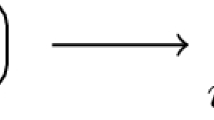Abstract
We modify the most used evolution strategy in membrane systems (namely that of maximal parallelism) by imposing a synchronization between rules. A synchronization over a set of rules can be applied only if each rule of the set can be applied at least once. For membrane systems working in the accepting mode, this synchronization is powerful enough to provide the computational completeness without any other ingredient (no catalysts, promoters, inhibitors, etc). The modeling power of synchronization is described by simulating the basic arithmetic operations (addition, subtraction, multiplication and division).




Similar content being viewed by others
References
Agrigoroaiei, O., & Ciobanu, G. (2010). Flattening the transition P systems with dissolution. Lecture Notes in Computer Science, 6501, 53–64.
Alhazov, A., Margenstern, M., & Verlan, S. (2009). Fast synchronization in P systems. Lecture Notes in Computer Science, 5391, 118–128.
Aman, B., & Ciobanu, G. (2008). Describing the immune system using enhanced mobile membranes. Electronic Notes in Theoretical Computer Science, 194(3), 5–18.
Aman, B., & Ciobanu, G. (2009). Turing completeness using three mobile membranes. Lecture Notes in Computer Science, 5715, 42–55.
Aman, B., & Ciobanu, G. (2011). Mobility in Process Calculi and Natural Computing. Berlin: Springer.
Aman, B., & Ciobanu, G. (2011). Solving a weak NP-complete problem in polynomial time by using mutual mobile membrane systems. Acta Informatica, 48(7–8), 409–415.
Aman, B., & Ciobanu, G. (2017). Efficiently solving the bin packing problem through bio-inspired mobility. Acta Informatica, 54(4), 435–445.
Aman, B., & Ciobanu, G. (2019). Adaptive P systems. Lecture Notes in Computer Science, 11399, 57–72.
Bernardini, F., Gheorghe, M., & Krasnogor, N. (2007). Quorum sensing P systems. Theoretical Computer Science, 371, 20–33.
Bernardini, F., Romero-Campero, F.J., Gheorghe, M., Pérez-Jiménez, M.J., Margenstern, M., Verlan, S., & Krasnogor, N. On P systems with bounded parallelism. In IEEE Computer Society Proceedings 7th SYNASC (pp. 399–406).
Bonchiş, C., Ciobanu, G., & Izbaşa, C. (2006). Encodings and arithmetic operations in membrane computing. Lecture Notes in Computer Science, 3959, 621–630.
Cavaliere, M., & Sburlan, D. (2005). Time and synchronization in membrane systems. Fundamenta Informaticae, 64(1–4), 65–77.
Ciobanu, G. (2010). Semantics of P systems. In The Oxford Handbook of Membrane Computing, Oxford: Oxford University Press (pp. 413–436).
Ciobanu, G., Pan, L., Păun, G., & Pérez-Jiménez, M. J. (2007). P systems with minimal parallelism. Theoretical Computer Science, 378, 117–130.
Ciobanu, G., Păun, G., & Pérez-Jiménez, M. J. (Eds.). (2006). Applications of Membrane Computing. Berlin: Springer.
Ciobanu, G., & Todoran, E. N. (2017). Denotational semantics of membrane systems by using complete metric spaces. Theoretical Computer Science, 701, 85–108.
Dinneen, M. J., Kim, Y.-B., & Nicolescu, R. (2012). Faster synchronization in P systems. Natural Computing, 11(1), 107–115.
Freund, R. (2005). Asynchronous P systems and P systems working in the sequential mode. Lecture Notes in Computer Science, 3365, 36–62.
Freund, R., Kari, L., Oswald, M., & Sosík, P. (2005). Computationally universal P systems without priorities: two catalysts are sufficient. Theoretical Computer Science, 330, 251–266.
Freund, R., & Păun, G. (2013). How to obtain computational completeness in P systems with one catalyst. Electronic Proceedings in Theoretical Computer Science, 128, 47–61.
Frisco, P., Gheorghe, M., & Pérez-Jiménez, M. J. (Eds.). (2014). Applications of Membrane Computing in Systems and Synthetic Biology. Berlin: Springer.
Gheorghe, M., & Ipate, F. (2014). A kernel P systems survey. Lecture Notes in Computer Science, 8340, 1–9.
Păun, G. (2002). Membrane Computing: An Introduction. Berlin: Springer.
Păun, G., Rozenberg, G., & Salomaa, A. (Eds.). (2010). The Oxford Handbook of Membrane Computing. Oxford: Oxford University Press.
Păun, G, & Sheng, Y. (1999). On synchronization in P systems. Fundamenta Informaticae, 38(4), 397–410.
Rozenberg, G., & Salomaa, A. (Eds.). (1997). Handbook of Formal Languages (Vol. 3). Berlin: Springer.
Zhang, G., Pérez-Jiménez, M. J., & Gheorghe, M. (2017). Real-Life Applications with Membrane Computing. Berlin: Springer.
Author information
Authors and Affiliations
Corresponding author
Additional information
Publisher's Note
Springer Nature remains neutral with regard to jurisdictional claims in published maps and institutional affiliations.
This work was presented at 20th Conference on Membrane Computing (CMC20)
Rights and permissions
About this article
Cite this article
Aman, B., Ciobanu, G. Synchronization of rules in membrane computing. J Membr Comput 1, 233–240 (2019). https://doi.org/10.1007/s41965-019-00022-1
Received:
Accepted:
Published:
Issue Date:
DOI: https://doi.org/10.1007/s41965-019-00022-1




